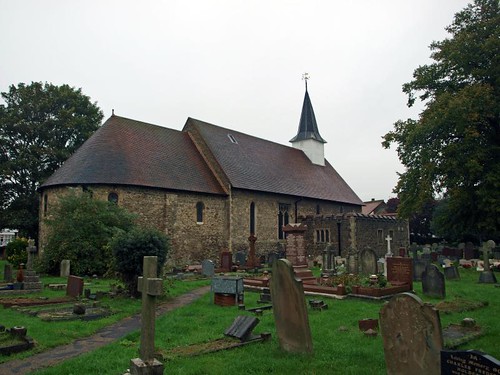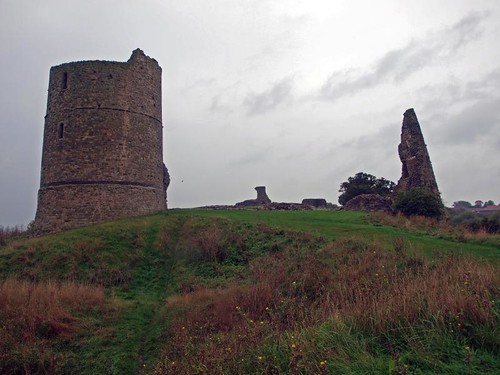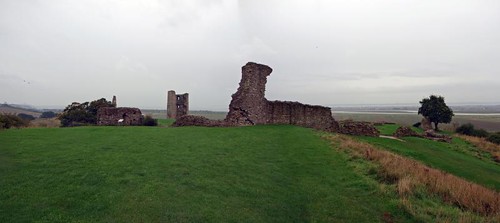ST JAMES THE LESS. A complete little Norman church, essentially unaltered, but unfortunately placed immediately S of an A-road with unsightly shops and shacks near its E end. This E end is apsed. A chancel precedes the apse, a nave the chancel. At the W end a boarded belfry resting inside on a free-standing four-post structure, the only later (C15) addition. Otherwise only a few windows are not original: nave N one C13 lancet, chancel S one two-light Dec window, nave S one two-light Perp window. - FONT. Made up of various parts. The best is the lower part of the bowl with stiff-leaf growing diagonally. - PAINTINGS . Very remarkable fragments. In the nave NE lancet demi-figure of St Thomas of Canterbury of c. 1275, in the window W of this Angel with spread-out wings (?), C13 ; on the wall further W trefoiled canopy said to be C14. - PLATE. Cup and Paten of 1568; both with bands of ornament.
HADLEIGH CASTLE is by far the most important later medieval castle in the county. It was built originally for Hubert de Burgh, Chief Justiciar, c. 1232, but then rebuilt by Edward III. It was in course of erection in 1365. The chief residential parts were to the S and have been entirely obliterated by a landslide. What survives is the W, N, and E curtain-wall, but not to any impressive height, the wall and one outer turret of the barbican on the N side, and four circular towers, all open towards the bailey. The highest, famous from Constable’s painting, is the SE tower. Here three storeys can still be recognized with windows and chimney flues. The tower to the N of this has two storeys remaining. The broadest tower is the one next to the barbican. The whole castle is of irregular oblong shape, and visually a little disappointing after the high hopes raised by Constable’s interpretation.
HADLEIGH. Its fame is in its Norman church and in the ruins of the home of two queens. Save for a few windows and doorways, the walls of the apse, chancel, and nave of the church are almost as the Norman builders left them. It is a joy to pass from the busy highway into this lovely old place. The chancel arch is only 18 feet high and not 11 feet wide. The font has foliage carved in the 13th century, and there is other carved stonework in niches. But the pride of the church is a painting of Thomas Becket on the splay of a window, made by an artist who may have seen him. It is from the years between 1170, when he was murdered, and 1173, when he was canonised. In the windows are modern portraits of Ethelburga, first Abbess of England’s first nunnery (at Barking) and the Evangelist of Essex, St Cedd.
Here in a field on the brow of a steep hill stand the ruins of Hadleigh Castle, with glorious views over the estuary of the Thames and of the coast of Kent merging into the horizon. The massive towers are magnificent, their walls being nine feet wide at the base, and the whole ruin covers about an acre. It was Hubert de Burgh who first built a castle here and Edward the First gave it to his queen. Rebuilt in 1365, it was made into one of the most remarkable Essex strongholds, and Henry the Eighth chose it as a home for his unwanted queen, Anne of Cleves. The ruins of this home of queens have been assured of lasting fame whatever may happen to them, for John Constable, who immortalised the northern boundary of Essex, came to admire and paint this lovely scene on its southern shore.
Here in a field on the brow of a steep hill stand the ruins of Hadleigh Castle, with glorious views over the estuary of the Thames and of the coast of Kent merging into the horizon. The massive towers are magnificent, their walls being nine feet wide at the base, and the whole ruin covers about an acre. It was Hubert de Burgh who first built a castle here and Edward the First gave it to his queen. Rebuilt in 1365, it was made into one of the most remarkable Essex strongholds, and Henry the Eighth chose it as a home for his unwanted queen, Anne of Cleves. The ruins of this home of queens have been assured of lasting fame whatever may happen to them, for John Constable, who immortalised the northern boundary of Essex, came to admire and paint this lovely scene on its southern shore.



No comments:
Post a Comment